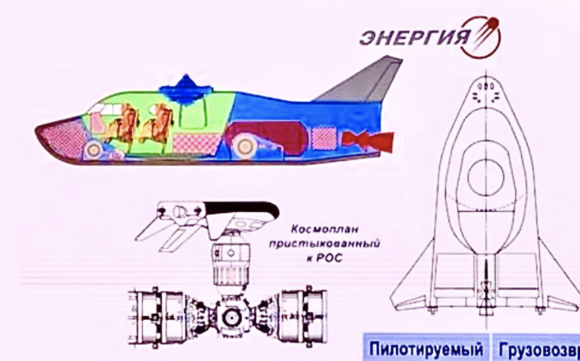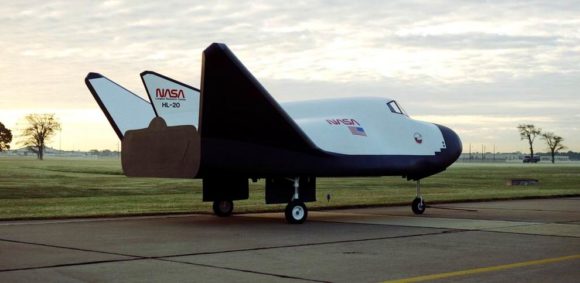With the country mired in the invasion of Ukraine, the Russian space program is not having its best moment. But this does not prevent Roscosmos and the Russian companies operating under its umbrella, such as RKK Energia or Khrunichev, from continuing to propose projects. The latest project, which seems to have come out of nowhere, is a spaceplane called Kosmoplán (Космоплан, “spaceplane” in Russian), which would ferry astronauts to the new Russian space station ROS. Kosmoplan was presented today, January 23, by the “general creator” of RKK Energia, former cosmonaut Vladimir Solovyov, at the Korolyovskie Chtenie Days – “Korolyov Readings” –, an annual meeting where projects of all kinds are discussed. The type related to the world of aviation.

Kosmoplan will be launched by an Angará A5M rocket from the Vostochny Cosmodrome with up to 4 astronauts. It will dock with the future Russian ROS station through a docking port located at the top of the fuselage and at the back it will carry the RD-0109 engine (used in the old Vostok rocket). It can carry up to 300 kg of cargo or in the unmanned version 1.8 tons. The advantage of this spaceplane over the future Soyuz or Oryol is its ability to perform hypersonic maneuvers in the high atmosphere, deviating from its course between 1,500 and 1,700 kilometers. During the return, this means being able to access a greater number of potential landing sites. Since the ROS system will be located in a polar orbit, this is the ability to Cross range During re-entry it is definitely very useful. Another advantage is the less deceleration that astronauts experience during reentry, which amounts to only 1.5 grams.


Come on, nothing we didn't already know since winged ships were studied decades ago. But what is the real need for this project? Well, basically, nothing. Russia has been developing the Oryol for more than a decade, so embarking on a new manned ship project before this new vehicle takes off makes no sense. It's true that Solovyov presented cosmoplane as a simple concept, but the simple fact that something like this could be proposed is surprising. Even more striking is the shape of the vehicle, which resembles a spiral spaceplane from the 1960s, which is striking because the last Russian spaceplane design, also by RKK Energia, was the Klíper, presented in the mid-2000s. However, RKK Energy appears to prefer a design four decades older.



The reason is that the design of the spiral was never forgotten. Let us remember that this design was used in the 1970s and 1980s in suborbital and orbital prototypes of BOR to test the heat shield of Buran. Previously, a spiral design had been briefly proposed for the Buran shuttle itself in 1976, although it was discarded in favor of a version of the Buran shuttle's exterior. Transportation service American due to Kremlin pressure. At the beginning of this century we saw proposals for Russian spaceplanes inspired by the spiral design. Regarding winged ships in general, the former head of Roscosmos, Dmitry Rogozin, four years ago proposed reviving the Buran (or a similar winged system). Come on, the winged ships haven't completely left Roscosmos' plans.


It is also surprising, but for other reasons, that many people were quick to describe this cosmoplane as a simple copy of the Dream Chaser from the American company Sierra Nevada. The exterior is similar, yes, but that's because the Dream Chaser has a design based on NASA Langley Center's HL-20 spaceplane project, which was developed between 1986 and 1995 based specifically on the aircraft's design. In the 1980s, the strange design of the BOR-4 was thoroughly studied in the United States and the HL-20 benefited from these aerodynamic studies). This means that the reason the Kosmoplán looks like the Dream Chaser is not because it is a copy of it, but because both vehicles use the BOR-4 design, which in turn is derived from the Spiral from the 1960s. In other words, however, the “copy” is the “dream chaser” and not the other way around.


On the other hand, Solovyov's presentation contributed to determining the development plans for the ROS station. Roscosmos wants to launch the first ROS module in 2027, the NEM, and in 2028 the first manned Oriole spacecraft will fly to the station. The station will be completed in 2030 in its basic configuration with NEM, BM (Bazovi Modul), UM node and ShM lock. Only that year would Russia abandon the International Space Station and focus on the ROS system. The large ROS modules will launch from Vostochny using Angará A5 rockets, as will Oriol spacecraft, although the latter will use Angará A5M. At the same time, Progress ROS cargo planes will be launched from Baikonur using Soyuz-2.1b rockets, a version of the Progress freighter adapted to this launch pad and new polar orbit (the current Soyuz and Progress use Soyuz-2.1a). ROS will have a small robotic arm and will generate 54 kilowatts instead of 6 kilowatts for the current Russian part of the ISS (the voltage will be 120 volts instead of 28 volts for the Russian part). The TPK Oriol spacecraft will carry between 2 and 4 astronauts and will have a mass of 17.8 tons. Later, RKK Energy wants to offer a cargo version of the Oriol capable of carrying cargo aft (non-pressurized cargo or a pressurized unit called DGO). This version will have the main engines on the sides.


The chances of Roscosmos building an ROS station within these time frames are certainly very low (so far we have only seen the NEM module under construction and the Oriole spacecraft has not yet made its first test flight, scheduled for 2027), but what is clear is that it is much larger than Opportunities to see Kosmoplan in action.

“Beer enthusiast. Subtly charming alcohol junkie. Wannabe internet buff. Typical pop culture lover.”
